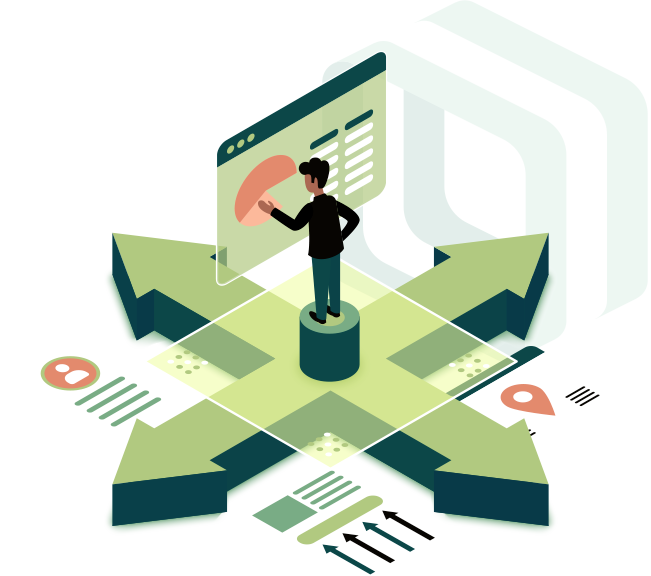Automated photorealistic renders of both the product and context for it
Entering the Age of Lean Commerce
How smart brands and manufacturers are paving a new path to growth and profitability
In today's fast-paced environment, companies must be both lean and nimble in their operations. Incorporating lean commerce allows for more efficiency and can help businesses in ways they may not have even considered. As Shigeo Shingo said, "The most dangerous kind of waste is the waste we do not recognize."
Through the use of lean commerce, businesses can be consistently agile and adaptable, which helps ensure they don't fall behind competitors or lose customers. This comprehensive guide to lean commerce will discuss:
- What this methodology is
- How it works
- The advantages of integrating it into your business
What is lean commerce?
Lean commerce is a new method of authentic start-up creation that's centered around both efficiency and nimbleness.
This methodology relies on product visualization, demand testing, CAD design, responsive product development and eCommerce-only and outsourced just-in-time manufacturing. The name "lean commerce" comes from the concept of lean manufacturing.
Precursors
In order to adapt to a leaner mode of operation, you must upgrade from outdated methodologies. Otherwise, as Henry Ford once said, "If you always do what you always did, you'll always get what you always got."
As such, before you can implement lean commerce, there are certain precursors to keep in mind. While the following concepts have helped businesses, they fall short of the capabilities of lean commerce.
Lean commerce is in the spirit of...
The future is already here – it's just not evenly distributed.”
— William Gibson
Demand testing
Demand planning and testing involve pre-announcing a new product without actually producing it to determine if there's demand for it. This is frequently done using a product mock-up along with a marketing campaign.
It's very similar to the first stage of a lean commerce eCommerce strategy, but it's missing the rest.
Dropshipping
Initially, dropshipping arose in the same spirit as lean commerce. However, it isn't as authentic because it is primarily oriented around reselling.
It often entails merely finding a cheap product overseas and creating a brand around it to sell it locally. Dropshipping has seen a surge in recent years as AliExpress and Amazon have begun more extensively distributing products from China and other countries.
Lean manufacturing
Lean manufacturing is a concept that operates on the principle of maximizing productivity while working to minimize waste during the manufacturing process. Through the use of lean manufacturing, businesses can benefit from reduced operating costs and lead times, along with improved overall product quality.

Etsy artisanship
Companies and individuals often use craft stores like Etsy. Although these are ideal for selling handcrafted products and other small offerings, sellers must build one of each offering, and sellers generally need to produce these products on their own. In other words, it limits you to artisan production.
Kickstarter
To get financing for a certain product, people may launch a Kickstarter campaign. However, with Kickstarter, there's typically only a prototype and then a months-long plan before launching the product. Because these campaigns may take as long as years to complete, plans for product delivery are particularly risky.
Another potential problem with Kickstarter is that these campaigns are often beaten to market by fast followers who can take the same idea and deliver it faster. This is due to the fact that Kickstarters usually rely on in-house manufacturing and fulfillment instead of focusing on product design and engaging partners on the delivery.
Product visualization
Businesses use computer imaging techniques to visualize products and develop product images, including static imagery, interactive visuals, and augmented reality experiences. eCommerce businesses can create a customer experience that replicates the in-store experience with interactive visualizations, eliminating the need for physical stores.
Made-to-order production
In many ways, lean commerce is made-to-order production taken to the extreme. In lean commerce, every offering is made-to-order with short lead times.
From the customer's perspective, the line is blurred between stock and made-to-order products because marketing and product experiences are similar to those often seen with established stock. This is possible due to the rich product experiences that interactive, high-fidelity product visualization offers.
Benefits of lean commerce
With the help of lean commerce, you can experience numerous advantages that trump outdated manufacturing processes. The optimization of your business operations through lean commerce can enable long-term success and put you miles ahead of less nimble competitors.
Nimble thought can jump both sea and land.”
— William Shakespeare
Going to market
Ultimately, with lean commerce, you can take your idea to market and sell it faster than ever. You'll be able to determine what you will sell using only computer design tools, simulation, and renders.
You can then market your product using renderings and interactive 3D, including augmented reality experiences that bring your renderings to life. This enables you to sell your product via eCommerce stores alone, without any need for physical stores to attract customers and boost sales.
Manufacturing advantages
Additionally, you'll have the ability to use outsourced just-in-time manufacturing both on- and off-shore, depending on your quality, cost, and expected delivery timeline requirements. You can also use dropshipping to move the goods from manufacturing directly to the consumer.
As a result of these lean processes, you'll benefit from increased capital efficiency with minimal investment requirements. Your business will also be more responsive and nimble overall, with increased profitability and a low cost of failure.
This, in turn, avoids physical store investments and their potential distraction. You'll also be able to avert inventory investments and the logistical hell involved in managing them.
In addition, you can avoid manufacturing investments and the bottlenecks seen with these processes.
At the same time, lean commerce enables you to:
- Own your customers
- Conduct customer demand tests that generate revenue
- Own your very own brilliant idea and product
That’s very different from dropshipping someone else's product. Also, unlike Etsy artisan businesses, you can scale as fast as you can sell, and you can launch a large product offering, which allows you to better understand your customers' needs.
Key components of a lean commerce company
If you want to use lean commerce to meet your business needs and optimize the supply chain, there are several key components of a lean commerce company to consider:

Emphasis on product visualization
Lean commerce companies rely on computer-aided design software and product visualization across the entire product lifecycle. This reduces or even eliminates the need for a physical store and physical products.
Innovative, manufacturable product ideas
With lean commerce practices, you can develop more innovative product ideas and actually deliver them.


Cost-effective outsourcing
Outside of product design and delivery, you can outsource everything else as you relentlessly drive toward continuous improvement of your product-market fit.
The ability to optimize
Once your company gains traction, you can continue to optimize your operations and offerings.


Increased automation of manufacturing
The orders your eCommerce website generates are directly manufacturable without significant effort on your part. They link back to the original CAD files and product options in a tight bundle that you can pass on to manufacturers.
Types of products that are good for a lean commerce company
Products that are most compatible with a lean commerce approach are those that are both well-defined and almost immediately manufacturable, all in a relatively straightforward manner and without highly specialized tooling.
Some good product fits for lean commerce include:
Furniture, including home and office furniture
Millwork, such as cabinetry
Commercial metalwork
Products that are compatible with CNC machining or 3D printing
Made-to-order or engineered-to-order products
Meanwhile, some bad product fits include:
Products that have unsolved problems in their designs that are unable to be instantly manufactured. These require additional research or a Kickstarter campaign to solve these problems.
Products that only you can produce because the process involves your personal creativity for each item, eliminating scalability. Etsy and other craft stores are more ideal for these items.
Products that involve big investments before manufacturing, including those that require expensive injection molding for unique parts. These products' manufacturing processes won't allow for a low investment approach. Instead, consider Kickstarter or modifying the design to make it more compatible with just-in-time manufacturing and delivery, including CNC machining and 3D printing capabilities.
Evolution of a lean commerce company
The initial stage of a lean commerce company won't last forever.
Once you begin selling your products, you'll realize that there are certain trends in the customer and order data you collect. These may include trends in location, seasonal products, or specific product styles.
Costs do not exist to be calculated. Costs exist to be reduced.”
—Taiichi Ohno
After identifying those trends, you can start to optimize toward them carefully. Some potential optimizations based on lean management principles may include:
Pre-ordering popular items — either evergreen or seasonal — in bulk to further reduce costs. However, this will start to build up inventory that needs to be stored.
Storing goods in warehouses located closer to customers to enable faster delivery.
Trying new products and styles around already-popular products to further expand the product range.
Replacing 3D-printed or CNC-machined components with injection-molded parts to reduce costs and increase overall professionalism once you're certain of the market demand.
Developing pop-up stores in locations, regions, and times where demand may be high. If these pop-up stores work, they'll confirm your hypothesis and give you a reason to develop more of them.
Thoughts to keep in mind during lean commerce adoption
It's important to keep in mind that many of these optimizations reduce the degree to which a company is executing lean commerce. In other words, it reduces the low capital investments and nimbleness of companies in favor of economies of scale.
Subsequently, as the business becomes increasingly sure of its product-market fit, along with the trends in the data it's collecting from customers and websites, the more it can invest in inventories and physical locations.
However, always be careful. Too much near-term focus on exploiting an opportunity can lead to you overinvesting in that opportunity. If the market shifts (as it is wont to do), you may then be saddled with a lot of low-performing assets.
How established businesses can adopt lean commerce
You don't need to start an entirely new business around lean commerce to benefit from it. Existing businesses can adopt these principles for process improvement and improved supply chain management.
At the same time, business owners need to understand that it won't be an overnight shift.
Adoption begins with increasing your investments in eCommerce experiences, especially in product experiences that reduce the need for customers to experience products physically before buying them.
If you have inventory, make sure it's profitable inventory. Otherwise, you should attempt to reduce it and focus more on speeding up lean manufacturing partners.
Consider whether you have started to launch products simply from CAD designs. You may have also used customer feedback and metrics from product launches and eCommerce product experiences to help guide your product development.
The trick here is to maintain your economies of scale and physical presences that provably generate positive returns. Simultaneously, you'll want to become more virtual to allow for increased nimbleness.

Software attributes that enable lean commerce
To succeed using lean commerce, you must have the ability to automate the creation of the whole range of product visualizations directly from CAD models, without the need for significant rework.
There are three key items you need, including:
Photorealistic renders
Interactive configurators
The ability to configure products in real time on the web page and update the graphics
Augmented reality
Assets that export to gITF and USDZ to showcase products in real-world settings without requiring customers to download an app
You also need to be able to generate manufacturing plans directly from your eCommerce checkouts, again using your original CAD designs and requiring minimal rework.
For example, you must have the option to specify CAD exports, such as RVT, STEP, IGES, DWG, and Inventor. Additionally, you'll need custom engineering drawings with dimensions to aid in manufacturing.
If you want your business to excel with lean commerce through high-quality product visualizations, click here to learn how Threekit's innovative platform can help.
Using Threekit, you can effectively adopt lean commerce processes to improve workflows and establish strong customer relationships. To get started on integration and find out how our virtual photography, product configuration, and augmented reality solutions can facilitate lean commerce, connect with us today.